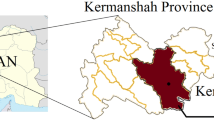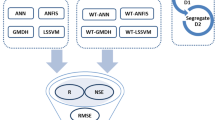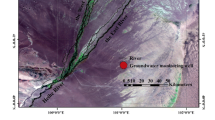Abstract
In recent decades, due to groundwater withdrawal in the Kabodarahang region, Iran, Hamadan, hazardous events such as sinkholes, droughts, water scarcity, etc., have occurred. This study models groundwater level (GWL) of the Kabodarahang region using two novel techniques including Self-Adaptive Extreme Learning Machine (SAELM) and Wavelet-Self-Adaptive Extreme Learning Machine (WA-SAELM). Using the stepwise selection as different lags along with different input combinations, ten different SAELM and WA-SAELM models were developed. First, the best activation function is chosen for numerical models. After that, GWL values were normalized to equalize the values and enhance speed and accuracy of modeling. Then, an optimized mother wavelet is selected in order to simulate GWLs. Next, the best model was introduced as the superior model in which values of the correlation coefficient (R), Root Mean Squared Error (RMSE) and Nash-Sutcliffe efficiency coefficient (NSC) were obtained 0.969, 0.358 and 0.939, respectively. In addition, the results of the superior model are compared with classical neural network models such as Artificial Neural Network (ANN), Wavelet-Artificial Neural Network (WA-ANN), Support Vector Machine (SVM) and Wavelet-Support Vector Machine (WA-SVM). Among all models, WA-SAELM approximated GWLs with higher accuracy. Furthermore, based on the results obtained from an uncertainty analysis, the superior model was identified as a model with an underestimated performance. Additionally, an explicit and practical matrix was proposed for computing GWLs. Finally, the matrix was validated for another piezometer.



Similar content being viewed by others
References
Adamowski J, Sun K (2010) Development of a coupled wavelet transform and neural network method for flow forecasting of non-perennial rivers in semi-arid watersheds. J Hydrol 390(1–2):85–91
Basak D, Pal S, Patranabis DC (2007) Support vector regression. Neural Inf Process 11:203–225
Bhattacharjya RK, Datta B (2009) ANN-GA-based model for multiple objective management of coastal aquifers. J Water Resour Plan Manag 135(5):314–322
Cao J, Lin Z, Huang GB (2012) Self-adaptive evolutionary extreme learning machine. Neural Process Lett 36:285–305
Cherkassky V, Ma Y (2004) Practical selection of SVM parameters and noise estimation for SVM regression. Neural Netw 17:113–126
Ebrahimi H, Rajaee T (2017) Simulation of groundwater level variations using wavelet combined with neural network, linear regression and support vector machine. Glob Planet Chang 148:181–191
Grossmann A, Morlet J (1984) Decomposition of hardy functions into square integrable wavelets of constant shape. SIAM J Math Anal 15(4):723–736
Haykin S (1999) Neural networks: a Comprehensive Foundation. Prentice Hall, Upper Saddle River
Huang GB, Zhu QY, Siew CK (2006) Extreme learning machine: theory and applications. Neurocomputing 70(1):489–501
Khaki M, Yusoff I, Islami N (2015) Simulation of groundwater level through artificial intelligence system. Environ Earth Sci 73(12):8357–8367
Kisi O, Shiri J (2012) Wavelet and neuro-fuzzy conjunction model for predicting water table depth fluctuations. Hydrol Res 43(3):286–300
Mayilvaganan MK, Naidu KB (2011) Application of artificial neural network for the prediction of groundwater level in hard rock region. In Trends in Computer Science, Engineering and Information Technology (673–682). Springer, Berlin: Heidelberg
Moeeni H, Bonakdari H, Ebtehaj I (2017) Integrated SARIMA with neuro-fuzzy systems and neural networks for monthly inflow prediction. Water Resour Manag 31(7):2141–2156
Moore EH (1920) On the reciprocal of the general algebraic matrix. Bull Am Math Soc 26(9):394–395
Nalarajan NA, Mohandas C (2015) Groundwater level prediction using M5 model trees. J Inst Eng (India): A 96(1):57–62
Nayak PC, Rao YS, Sudheer KP (2006) Groundwater level forecasting in a shallow aquifer using artificial neural network approach. Water Resour Manag 20(1):77–90
Nourani V, Hosseini Baghanam A, Adamowski J, Kisi O (2014) Applications of hybrid wavelet–artificial intelligence models in hydrology: a review. J Hydrol 514:358–377
Rajesh R, Prakash JS (2011) Extreme learning machines-a review and state-of-the-art. Int J Wisdom Based Comput 1(1):35–49
Shirmohammadi B, Vafakhah M, Moosavi V, Moghaddamnia A (2013) Appl Sev data driven tech predicting Groundw level. Water Resour Manag 27:419–432
Silhavy R, Silhavy P, Prokopova Z (2017) Analysis and selection of a regression model for the use case points method using a stepwise approach. J Syst Softw 125:1–14
Singh RM (2012) Wavelet-ANN model for flood events, Proceedings of the International Conference on Soft Computing for Problem Solving (SocProS 2011) Springer, India. 165–175
Storn R, Price K (1997) Differential evolution–a simple and efficient heuristic for global optimization over continuous spaces. J Glob Optim 11(4):341–359
Vapnik VN (1998) Statistical learning theory. Wiley, New York
Author information
Authors and Affiliations
Corresponding author
Ethics declarations
Conflict of Interest
None.
Additional information
Publisher’s Note
Springer Nature remains neutral with regard to jurisdictional claims in published maps and institutional affiliations.
Rights and permissions
About this article
Cite this article
Malekzadeh, M., Kardar, S., Saeb, K. et al. A Novel Approach for Prediction of Monthly Ground Water Level Using a Hybrid Wavelet and Non-Tuned Self-Adaptive Machine Learning Model. Water Resour Manage 33, 1609–1628 (2019). https://doi.org/10.1007/s11269-019-2193-8
Received:
Accepted:
Published:
Issue Date:
DOI: https://doi.org/10.1007/s11269-019-2193-8




